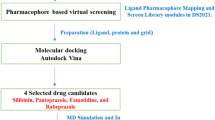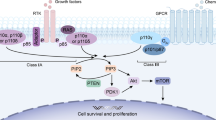Abstract
Based on a structure-activity relationship of compounds such as Sorafenib and Quizartinib, a series of thiazol-urea derivatives containing hydrophilic side moiety were designed and synthesized, aiming to improve the druggability of target compounds. Among them, compound 6h exhibited the best anti-hepatocellular carcinoma activity, especially against HepG2 cells with an IC50 of 5.62 μM. In addition, compound 6h was able to suppress the formation of HepG2 colonies. Mechanism studies revealed that compound 6h effectively inhibited C-RAF/FLT3 kinases. Furthermore, compound 6h was able to inhibit the rapid proliferation, and exerted marked migration inhibitory effects on HepG2 cells. Moreover, compound 6h induced cell cycle arrest in G2/M phase and led to cell apoptosis. Besides, ADMET properties prediction showed that compound 6h had more aqueous solubility than Sorafenib. Collectively, these results suggested that compound 6h represents a novel C-RAF/FLT3 inhibitor deserving further investigation.







Similar content being viewed by others
References
Kantarjian H, Jabbour E, Grimley J, Kirkpatrick P. Dasatinib. Nat Rev Drug Discov. 2006;5:717–9. https://doi.org/10.1038/nrd2135.
Ballantyne AD, Garnock-Jones KP. Dabrafenib: first global approval. Drugs. 2013;73:1367–76. https://doi.org/10.1007/s40265-013-0095-2.
Andre F, Ciruelos E, Rubovszky G, Campone M, Loibl S, Rugo HS. et al. Alpelisib for PIK3CA-mutated, hormone receptor–positive advanced breast cancer. N. Engl J Med. 2019;380:1929–40. https://doi.org/10.1056/NEJMoa1813904.
Wang S, Midgley CA, Scaërou F, Grabarek JB, Griffiths G, Jackson W. et al. Discovery of N-phenyl-4-(thiazol-5-yl) pyrimidin-2-amine aurora kinase inhibitors. J Med Chem. 2010;53:4367–78. https://doi.org/10.1021/jm901913s.
Alizadeh SR, Hashemi SM. Development and therapeutic potential of 2-aminothiazole derivatives in anticancer drug discovery. Med Chem Res. 2021;30:771–806. https://doi.org/10.1007/s00044-020-02686-2.
Wan Y, Long J, Gao H, Tang Z. 2-Aminothiazole: A privileged scaffold for the discovery of anti-cancer agents. Eur J Med Chem. 2021;210:112953. https://doi.org/10.1016/j.ejmech.2020.112953.
Liu Y, Gray NS. Rational design of inhibitors that bind to inactive kinase conformations. Nat Chem Biol. 2006;2:358–64. https://doi.org/10.1038/nchembio799.
Wang Z, Cai J, Cheng J, Yang W, Zhu Y, Li H. et al. FLT3 inhibitors in acute myeloid leukemia: challenges and recent developments in overcoming resistance. J Med Chem. 2021;64:2878–2900. https://doi.org/10.1038/nchembio799.
Dokla EME, Abdel-Aziz AK, Milik SN, McPhillie MJ, Minucci S, Abouzid K. Discovery of a benzimidazole-based dual FLT3/TrKA inhibitor targeting acute myeloid leukemia. Bioorg Med Chem. 2022;56:116596. https://doi.org/10.1016/j.bmc.2021.116596.
Nasiri AH, Saxena K, Bats JW, Nasiri HR, Schwalbe H. Biophysical investigation and conformational analysis of p38α kinase inhibitor doramapimod and its analogues. MedChemComm. 2016;7:1421–8. https://doi.org/10.1039/C6MD00262E.
Walker MA. Improvement in aqueous solubility achieved via small molecular changes. Bioorg Med Chem Lett. 2017;27:5100–8. https://doi.org/10.1016/j.bmcl.2017.09.041.
Zhao F, Lin Z, Wang F, Zhao W, Dong X. Four-membered heterocycles-containing 4-anilino-quinazoline derivatives as epidermal growth factor receptor (EGFR) kinase inhibitors. Bioorg Med Chem Lett. 2013;23:5385–8. https://doi.org/10.1016/j.bmcl.2013.07.049.
Wang XX, Tian FY, Liu M, Chen K, Zhang YQ, Zhu QJ. et al. A water soluble tetramethyl-substituted cucurbit [8] uril obtained from larger intermediates?. Tetrahedron. 2019;75:130488. https://doi.org/10.1016/j.tet.2019.130488.
Kuczynski EA, Vermeulen PB, Pezzella F, Kerbel RS, Reynolds AR. Vessel co-option in cancer. Nat Rev Clin Oncol. 2019;16:469–93. https://doi.org/10.1038/s41571-019-0181-9.
Wan PT, Garnett MJ, Roe SM, Lee S, Niculescu-Duvaz D, Good VM. et al. Mechanism of activation of the RAF-ERK signaling pathway by oncogenic mutations of B-RAF. Cell. 2004;116:855–67. https://doi.org/10.1016/S0092-8674(04)00215-6.
Zorn JA, Wang Q, Fujimura E, Barros T, Kuriyan J. Crystal structure of the FLT3 kinase domain bound to the inhibitor quizartinib (AC220). PloS one. 2015;10:e0121177. https://doi.org/10.1371/journal.pone.0121177.
Liao JJL. Molecular recognition of protein kinase binding pockets for design of potent and selective kinase inhibitors. J Med Chem. 2007;50:409–24. https://doi.org/10.1021/jm0608107.
Pires DEV, Blundell TL, Ascher DB. pkCSM: predicting small-molecule pharmacokinetic and toxicity properties using graph-based signatures. J Med Chem. 2015;58:4066–72. https://doi.org/10.1021/acs.jmedchem.5b00104.
Garrido A, Lepailleur A, Mignani SM, Dallemagne P, Rochais C. hERG toxicity assessment: Useful guidelines for drug design. Eur J Med Chem. 2020;195:112290. https://doi.org/10.1016/j.ejmech.2020.112290.
Zhang Z, Chen Y, Wu H, Cui B, **ong W, Lin T. et al. Design, Synthesis, and Biological Evaluation of Novel 2-Amino-4-phenylthiazole Derivatives as c-Met Inhibitors. Chin J Org Chem. 2018;38:2648–56. https://doi.org/10.6023/cjoc201803041.
Dai H, Si X, Wang H, Wang Z, Liu L, Qian Z, et al. Design, synthesis and anti-tumor activity evaluation of 4, 6, 7-substitute quinazoline derivatives[J]. Med Chem Res. 2022: 1-18. https://doi.org/10.1007/s00044-022-02897-9.
Shi G, Shaw G, Liang YH, Subburaman P, Li Y, Wu Y. et al. Bisubstrate analogue inhibitors of 6-hydroxymethyl-7, 8-dihydropterin pyrophosphokinase: New design with improved properties[J]. Bioorg Med Chem. 2012;20:47–57. https://doi.org/10.1016/j.bmc.2011.11.032.
Dai Y, Hartandi K, Ji Z, Ahmed AA, Albert DH, Bauch JL. et al. Discovery of N-(4-(3-Amino-1 H-indazol-4-yl) phenyl)-N ‘-(2-fluoro-5-methylphenyl) urea (ABT-869), a 3-aminoindazole-based orally active multitargeted receptor tyrosine kinase inhibitor[J]. J Med Chem. 2007;50:1584–97. https://doi.org/10.1021/jm061280h.
Masoud GN, Youssef AM, Abdel Khalek MM, Abdel Wahab AE, Labouta IM, Hazzaa AAB. Design, synthesis, and biological evaluation of new 4-thiazolidinone derivatives substituted with benzimidazole ring as potential chemotherapeutic agents[J]. Med Chem Res. 2013;22:707–25. https://doi.org/10.1007/s00044-012-0057-3.
Casalvieri KA, Matheson CJ, Backos DS, Reigan P. Substituted pteridinones as p90 ribosomal S6 protein kinase (RSK) inhibitors: A structure-activity study. Bioorg Med Chem. 2020;28:115303. https://doi.org/10.1016/j.bmc.2019.115303.
Yang T, Zhang W, Cao S, Sun S, Cai X, Xu L. et al. Discovery of highly potent and selective EGFRT790M/L858R TKIs against NSCLC based on molecular dynamic simulation. Eur J Med Chem. 2022;228:113984 https://doi.org/10.1016/j.ejmech.2021.113984.
Acknowledgements
We gratefully acknowledge the financial support from the Natural Science Foundation of Liaoning Province (2019-ZD-0693 and 2021-MS-336).
Author information
Authors and Affiliations
Corresponding author
Ethics declarations
Conflict of interest
The authors declare no competing interests.
Additional information
Publisher’s note Springer Nature remains neutral with regard to jurisdictional claims in published maps and institutional affiliations.
Supplementary Information
Rights and permissions
Springer Nature or its licensor holds exclusive rights to this article under a publishing agreement with the author(s) or other rightsholder(s); author self-archiving of the accepted manuscript version of this article is solely governed by the terms of such publishing agreement and applicable law.
About this article
Cite this article
Zhang, ZH., Zeng, BF., Song, ZX. et al. Synthesis and biological evaluation of new thiazolyl-urea derivatives as potential dual C-RAF/FLT3 inhibitors. Med Chem Res 31, 1862–1874 (2022). https://doi.org/10.1007/s00044-022-02971-2
Received:
Accepted:
Published:
Issue Date:
DOI: https://doi.org/10.1007/s00044-022-02971-2




